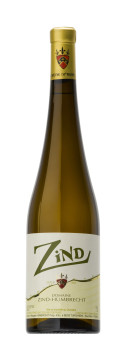
Technical presentation
| Bottling : | September 2009 |
|---|---|
| Acquired alcohol : | 12.5° |
| Residual sugar : | 7.5 g/l |
| Total acidity : | 4.6 g/l H2SO4 / (7.0 g/l Tartrique) |
| pH : | 3.3 |
| Yield : | 59 hl/ha |
| Average age of vines : | 19 years |
| Terroir : | Clos Windsbuhl |
| Sweetness index : | 1 |
| Soil : | Muschelkalk calcareous, South/South East facing |
Description of the wine Zind 2008
The Zind label was created in 2001 after a lengthy ‘discussion’ with INAO in order to allow the Chardonnay grape into the AOC Alsace. Unfortunately (or fortunately now?) our request has been refused and we had to label this wine Vin de Table. We loose the word Alsace on the label, but gain quite some freedom in making this wine as we want. Since 2004, as the vines turned 15 years old, we decided to make the Zind only from the Chardonnay (65%) and Auxerrois (35%) from the Clos Windsbuhl vineyard. The 2008 was perhaps harvested at the exact balance that we try to aim between the richness, acidity and residual sweetness. The grapes were healthy and the slow ripening late September/early October made this very easy to achieve in 2008.

Tasting notes
02/2010 : The Zind 2008 was partially fermented and aged in a large new oak cask (82hl). Unfortunately, we had to change one of our very old foudre and decided to put part of the Zind in the new one. These casks aren’t as toasted as smaller barriques and the ration wine/wood is much higher so there is less influence of the oak on the wine. The structure is very clean, showing crisp acidity and a long pure mineral palate. Precise tasters will find the light wood influence mostly on the finish. Perfect for every occasion, mostly with spicy food, fish and light meals…

The Clos Windsbuhl of Hunawihr
The altitude of the vineyard coupled with Hunawihr’s tardy climate means that the Clos Windsbuhl is often one of the last of our vineyards to be harvested. This explains the aromatic quality of the Clos’ wines and the consistent balance of acidity, a guarantee of good ageing. Although often harvested late, the Windsbuhl grapes are only rarely botryitized, doubtless due to the altitude of the vineyard, but nevertheless often reach high levels of maturity.